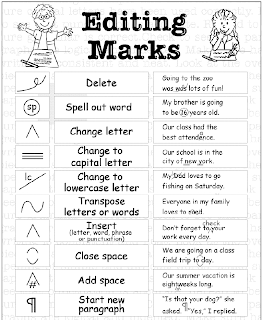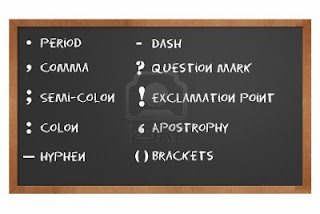 Focused Free-writing:
Focused Free-writing:
If you had to spend the rest of your life in the company of a single type of animal, which would you choose? Explain.
Many responses to this topic have been a parrot, dog, or cat. Many choose these types of animals because they want company. If for the rest of their lives they are in the company of this type of animal, then they would want some company. I found it interesting, that some chose the parrot to have someone to talk to, a dog so they have an obedient companion. Many times they have chosen their favorite animals, animals they completely adore, so it would be interesting to see what is the favorite of my students.
Editing Marks
Tonight's lesson was on Editing Marks also known as Proof Reader's Marks, the marks I use to correct students' papers. I explained how I mark where a capital letter should be, an insert, delete and so on. I handed out a sheet to follow, and I also went over some editing marks not found on the sheet that I use, for example to put a word in italics, bold, and so on.
Before our editing marks lesson, I went over a couple of things to avoid in formal essay writing. Try not to use contractions, slang, vague words. Hopefully, my students will start to avoid using those things when writing.
Here are some editing marks I use
Punctuation: The Traffic Signs of Writing
We also went over how punctuation marks are used in writing. When I introduced punctuation marks I told the students imagine if the roads that we drive our cars on had no traffic signs or traffic lights. People would be driving their cars everywhere, not knowing when to stop or where to go. It would be very confusing. Periods, commas, colons, and other punctuation marks operate like traffic signs and lights for readers. They tell us when to stop, when to slow down, and when to keep going. When writers use the correct punctuation, they are helping readers travel through their writing.
The period is like a stop sign. It is placed at the end of a sentence, a complete thought. The question a writer should ask is, "When do I need to stop?" To figure out where one sentence ends and another begins, look for the place where one idea or thought ends and a new one begins. Often writers will have trouble with periods when they want to join more than one idea together. One of the best ways to know when to put in a period is to reread the writing out loud. If you need to stop and take a deep breath, then you know a period is needed.
The comma is thought of as a yield sign, telling the reader to slow down. We can use a comma to join two complete ideas together, or several commas and a conjunction following the last when we are listing a series of items. Like a period, the best way to find out where to put a comma is to reread the writing out loud. Usually, when you have to gasp for a short breath, insert a comma. But remember, don't over do it, sometimes a comma will occur only once in a sentences or not at all. Conjunction words, like and, or, but do not need the comma, but it depends how we use the words in our writing.
The most common misused punctuation is the semi-colon. If a student is unsure about a semi-colon, they should not be using it. Many times when students use the semi-colon they are misusing this punctuation. A semi-colon is a period and comma put together, so it is telling us, stop, but not completely, just enough to take a breath but not a deep long breath--move on, because there is a greater/complementing/shorter idea coming. When a semi-colon is used in a sentence usually there are two ideas in the sentence, the first being the longest (largest) and the second just complementing it (shorter) so we would find the semi-colon right between the two ideas. But I constantly reminded my students, when in doubt, leave it OUT!
We also went over other punctuation marks in English writing, opening up a whole new world for some, and others just a review of what they have already learned. If used properly punctuation marks enhance the writing, making it easy to understand.
Images taken from: http://www.teacherweb.com/FL/ManateeElementary/CynthiaMiller/6-1-Editing-Marks.png, http://www.123rf.com/photo_9465383_chalkboard-showing-punctuation-marks-with-clipping-path-at-this-size.html, http://www3.canisius.edu/~grandem/animalshabitats/SOFTCHALKGOOD_print.html


No comments:
Post a Comment